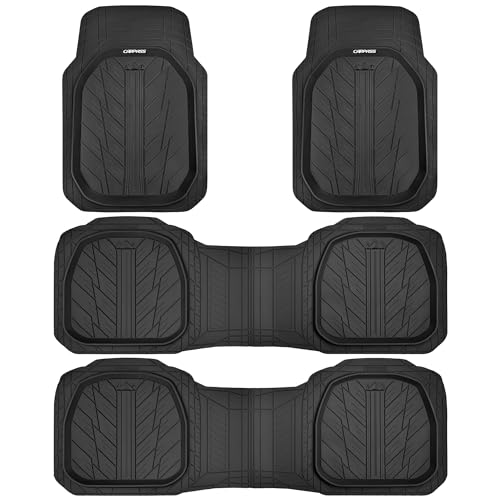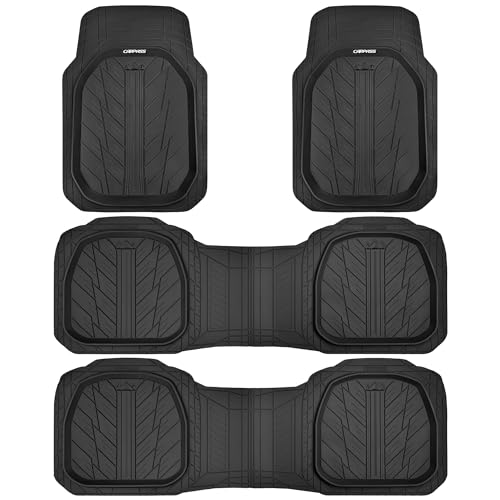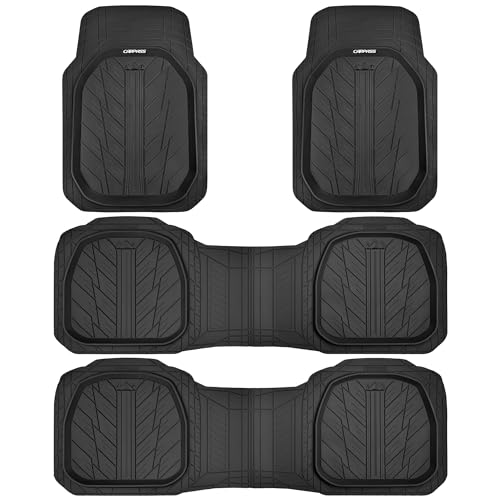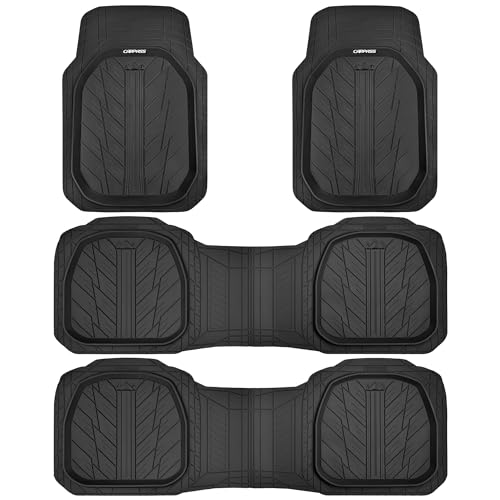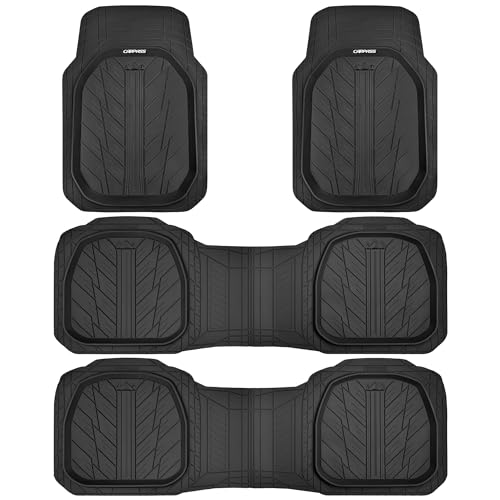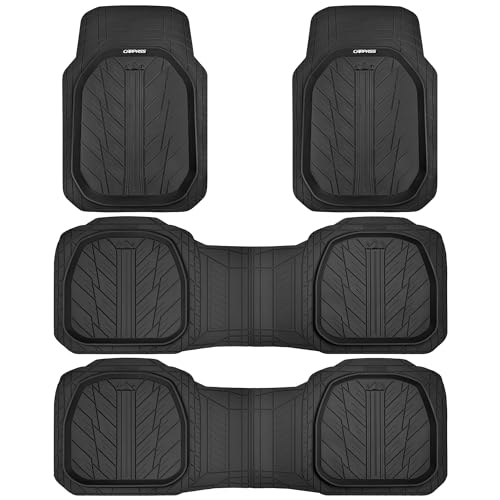
SUV Features Checklist
When selecting an SUV, it’s essential to look at the safety and security features it offers. Advanced features like adaptive cruise control, lane departure warnings, and blind-spot monitoring can make driving much safer. Moreover, many SUVs now come with automatic emergency braking and pedestrian detection systems. These features can prevent accidents or reduce their severity. Additionally, anti-theft systems and alarms provide extra security for your vehicle.
Performance is another important aspect of an SUV. Modern SUVs often come with powerful engines that provide great acceleration and towing capabilities. All-wheel drive or four-wheel drive options can improve traction and handling in various weather conditions. Additionally, adaptive suspension systems can offer a smoother ride on rough terrain. These features combined ensure that your SUV isn’t just practical but also fun to drive.
Comfort and luxury features can make a big difference on long road trips or daily commutes. Most SUVs include adjustable leather seats, climate control systems, and plenty of cabin space. Many even offer heated and ventilated seats, which can make traveling more enjoyable. A panoramic sunroof can give passengers a great view and bring more light into the cabin. These touches add to the overall experience, making the journey as enjoyable as the destination.
Tech-savvy features have also become a standard in modern SUVs. Infotainment systems with large touchscreens, navigation, and smartphone integration are commonly available. Additionally, many SUVs now come with multiple USB ports, wireless charging, and premium sound systems. Advanced driver assistance systems can provide semi-autonomous driving capabilities. These technologies not only add convenience but also enhance safety and entertainment for everyone in the vehicle.
Safety and Security Features
Safety and security features are crucial elements for any SUV. Many models now come with advanced driver assistance systems (ADAS) that include features like automatic emergency braking (AEB) and lane-keeping assist. These systems can automatically apply brakes to prevent a collision and keep your vehicle centered in its lane. Blind-spot monitoring also alerts drivers to nearby vehicles they might not see. Having these features can significantly reduce the risk of accidents.
Modern SUVs often incorporate sophisticated airbag systems. These systems include multiple airbags positioned around the cabin to protect passengers in case of a crash. Side curtain airbags offer additional protection by covering the side windows during impact. This feature is especially helpful in rollover accidents. The effectiveness of these airbag systems can be crucial in saving lives.
Anti-theft systems are an essential part of the security features in an SUV. Keyless entry and ignition systems are common, but they also come with measures to prevent unauthorized access. Many SUVs feature alarm systems that activate if someone tries to break in. Some models even offer GPS tracking to locate a stolen vehicle. These features help to deter theft and give owners peace of mind.
Child safety is another important aspect when it comes to family SUVs. Many models are equipped with LATCH (Lower Anchors and Tethers for Children) systems for easy and secure installation of child seats. Rear-seat alert systems can remind the driver to check the back seat before leaving the vehicle, reducing the risk of accidentally leaving a child inside. Additionally, features like child door locks and window safety locks can keep younger passengers safe and secure. These elements ensure the vehicle is not only safe for adults but also for children.
Performance Features in an SUV
Performance features in an SUV play a vital role in enhancing driving experience and efficiency. Most modern SUVs come equipped with powerful engines that deliver substantial horsepower and torque. This allows for better acceleration and towing capacity, making them ideal for both city driving and outdoor adventures. Many models also feature different driving modes that adjust throttle response and steering feel. These modes can optimize performance for various driving conditions, from highway cruising to off-road trails.
Suspension systems are another critical performance feature in SUVs. Advanced suspension systems, such as independent rear suspension and adaptive dampers, provide a smoother ride over rough terrain. These systems work by adjusting the stiffness of the suspension based on driving conditions. As a result, they enhance comfort and stability. Whether you’re driving on a bumpy road or a smooth highway, a good suspension system can make a significant difference.
All-wheel drive (AWD) and four-wheel drive (4WD) systems are common performance features in SUVs. These systems distribute power to all four wheels, improving traction and control. They are especially useful in adverse weather conditions like rain, snow, or mud. Some SUVs come with advanced traction control systems that work alongside AWD or 4WD. These systems can automatically detect and adapt to road conditions to provide optimal grip.
Fuel efficiency has also become a key performance indicator for SUVs. Many modern SUVs are now equipped with engines that offer better fuel economy without sacrificing power. Hybrid and electric variants provide even greater efficiency and reduced emissions. Advanced aerodynamics and lightweight materials also contribute to better fuel efficiency. These features make SUVs not only powerful but also economical and environmentally friendly.
Comfort and Luxury Features
Comfort and luxury features can transform an SUV from a basic vehicle into a rolling sanctuary. One of the most sought-after features is adjustable leather seats, often equipped with heating and cooling elements. These seats can make every ride, whether short or long, extremely pleasant. They are especially beneficial in climates with extreme temperatures. Passengers will appreciate the added comfort these features provide.
A state-of-the-art climate control system is another essential luxury feature in an SUV. Dual or tri-zone climate controls allow the driver and passengers to set individual temperature preferences. This system can ensure that everyone in the vehicle is comfortable, regardless of the weather outside. Some SUVs even have air purifiers and fragrance diffusers built in. This adds an extra layer of comfort and luxury to the driving experience.
Spacious interiors with flexible seating arrangements make SUVs versatile vehicles. Features like split-folding rear seats and sliding second-row seats provide plenty of options for carrying passengers and cargo. These seating configurations offer an array of possibilities for both everyday commutes and family vacations. In addition, ample legroom and headroom contribute to a more relaxed journey. No one likes to feel cramped, especially on long trips.
Entertainment options are also top-notch in many luxury SUVs. Infotainment systems often include large touchscreens with high-definition displays. These systems support smartphone integration, allowing users to access maps, music, and apps seamlessly. Additionally, many SUVs come with premium sound systems, ensuring that every road trip or commute is accompanied by high-quality audio. Rear-seat entertainment systems with screens for passengers can make long journeys more enjoyable for families.
Advanced driver comfort features include adaptive cruise control and heads-up displays. Adaptive cruise control can maintain a set distance from the car ahead, reducing the need to constantly adjust speed. A heads-up display projects important information, like speed and navigation, onto the windshield, helping the driver to keep their eyes on the road. Such features add a layer of convenience and safety. These technologies make driving less stressful and more enjoyable.
Storage solutions are abundant in modern SUVs, enhancing both comfort and luxury. From spacious glove compartments to under-floor storage bins, these compartments help keep the cabin organized. Some models also feature power liftgates and hands-free tailgates for easy loading and unloading of cargo. These features are especially useful for busy families and frequent travelers. They make every aspect of the journey more convenient and enjoyable.
Tech-Savvy Features
Tech-savvy features in SUVs are designed to make driving more enjoyable and convenient. Infotainment systems with large touchscreens are a common feature. These systems often include navigation, app compatibility, and voice command. Many also support Apple CarPlay and Android Auto, allowing you to sync your smartphone seamlessly. This makes accessing your favorite features simple and safe.
Advanced driver assistance systems (ADAS) are another tech-savvy feature in modern SUVs. These systems include adaptive cruise control, lane-keeping assist, and automatic emergency braking. Adaptive cruise control maintains a set distance from the car ahead. Lane-keeping assist helps keep the vehicle centered in its lane. These features can reduce driver fatigue and increase safety.
- Wireless charging pads
- Multiple USB ports
- Premium sound systems
- Over-the-air software updates
- Wi-Fi hotspots
Many SUVs offer features that connect your car to the internet. Built-in Wi-Fi hotspots are now standard in many luxury models. This allows passengers to stay connected on the go. Over-the-air software updates can also keep your vehicle’s systems up-to-date. This ensures you always have the latest features and security patches.
Tech-savvy SUVs also include advanced parking assist systems. These systems can help with parallel parking or even park the car for you. Sensors and cameras assist in detecting obstacles and guiding the vehicle. This feature is particularly useful in tight spots or busy urban areas. It takes the stress out of parking and makes it easier for everyone.
Eco-Friendly SUV Features
Eco-friendly features in SUVs are becoming more popular as people look to reduce their carbon footprint. Hybrid engines, which combine a gasoline engine with an electric motor, are a common feature. This setup can offer better fuel efficiency and lower emissions. Many models also come with plug-in hybrid options. These allow drivers to charge the vehicle’s battery for even greater fuel savings.
Electric SUVs are another option for eco-conscious drivers. These vehicles run solely on electricity, producing zero tailpipe emissions. They often come with larger batteries that provide extended driving ranges between charges. Charging stations are becoming more widespread, making it easier to own and operate an electric SUV. This makes them a practical choice for everyday use.
- Regenerative braking systems
- Eco-driving modes
- Lightweight materials
- Aerodynamic designs
Regenerative braking is another eco-friendly feature found in modern SUVs. This system captures energy that would otherwise be lost during braking and uses it to recharge the battery. It enhances fuel efficiency and extends the range of electric and hybrid vehicles. Many SUVs also come with eco-driving modes. These modes adjust the vehicle’s performance to maximize fuel economy.
Lightweight materials and aerodynamic designs also contribute to the eco-friendliness of SUVs. Using materials like aluminum and high-strength steel can reduce the vehicle’s overall weight. This improves fuel efficiency and reduces emissions. Aerodynamic designs help to minimize drag, making the vehicle more efficient at higher speeds. Both features work together to make SUVs more environmentally friendly.
Many eco-friendly SUVs are also designed with sustainable materials. Interiors may feature upholstery made from recycled plastics or natural fibers. Eco-conscious manufacturing processes aim to reduce the environmental impact during production. By choosing an eco-friendly SUV, drivers can enjoy modern comforts while making a positive difference. These features combine practicality with sustainability.
Key Takeaways
- Advanced safety systems make SUVs safer to drive.
- Performance enhancers like all-wheel drive improve handling.
- Luxury amenities add comfort and enjoyment to drives.
- Tech features like touchscreens enhance usability.
- SUVs offer a mix of safety, performance, and luxury.
Frequently Asked Questions
When it comes to SUVs, there are plenty of features to consider. Below are some common questions about these features and their importance.
1. What are the most important safety features in an SUV?
Advanced safety features like adaptive cruise control and automatic emergency braking are crucial in modern SUVs. These technologies can help prevent accidents by keeping safe distances and stopping the vehicle when needed.
Other valuable safety features include lane-keeping assist and blind-spot monitoring. These systems alert you to potential hazards, making driving safer for everyone on the road.
2. How does all-wheel drive improve SUV performance?
All-wheel drive (AWD) enhances traction and stability by distributing power to all four wheels. This is especially useful in adverse weather conditions like rain, snow, or mud.
Apart from improving grip on slippery surfaces, AWD also aids in better handling during off-road adventures. It’s a key feature for those who love exploring different terrains.
3. Are luxury features in an SUV worth the extra cost?
Luxury features like leather seats and premium sound systems make rides more enjoyable but come at a higher cost. For many people, these add-ons provide comfort that justifies the expense, especially on long trips.
If you frequently travel with family or take long commutes, investing in luxury amenities can enhance your overall experience. Features like heated seats and advanced climate control contribute significantly to comfort.
4. What tech features should I look for in an SUV?
An excellent infotainment system with a large touchscreen is vital for usability and convenience. Look for models supporting Apple CarPlay or Android Auto for seamless smartphone integration.
Other tech-savvy features include built-in Wi-Fi hotspots and advanced driver assistance systems (ADAS). These technologies add both convenience and an extra layer of safety to your driving experience.
5. How do hybrid engines make SUVs more eco-friendly?
Hybrid engines combine a gasoline engine with an electric motor, reducing fuel consumption and emissions. These engines offer improved fuel efficiency while maintaining decent power levels for everyday use.
You may also find plug-in hybrid options that allow for battery charging, further enhancing fuel savings. Hybrid SUVs contribute positively toward environmental sustainability without sacrificing performance.


